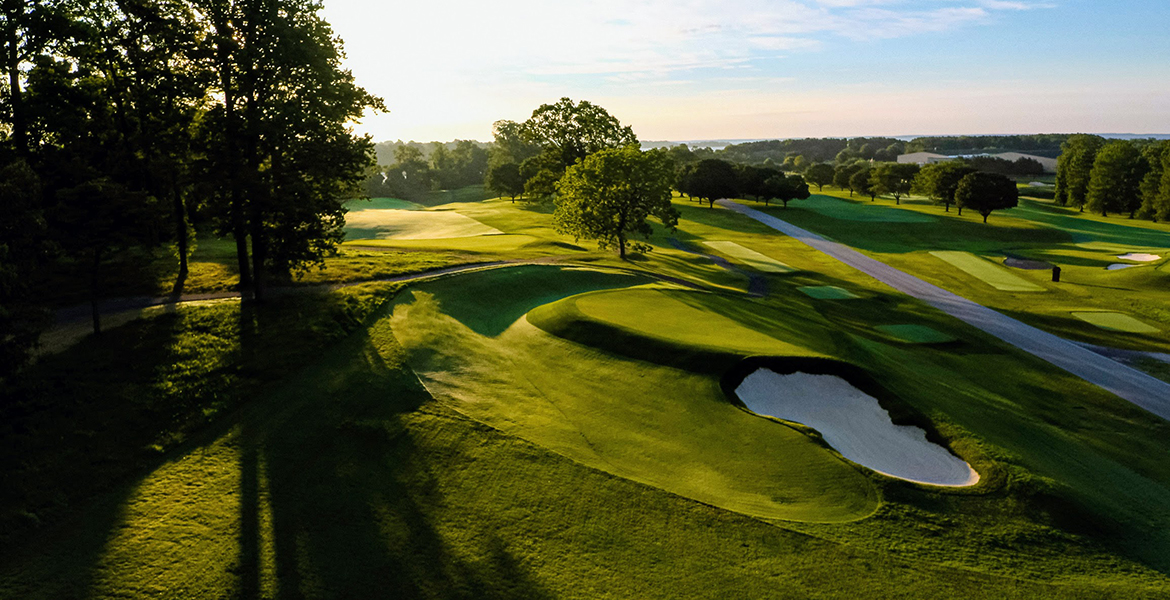When Tiger Woods won his first Open Championship in 2000 at the Old Course at St. Andrews, people marveled at his 8-shot margin of victory. But what’s arguably more impressive is the fact that not once during the four days did he hit into a bunker. This would be remarkable on any golf course, but to avoid all 112 bunkers on the Old Course—a links course, where the vagaries of the wind and the unpredictable kicks you can get off the tight, sloping fairways challenge even the best players—well, it’s nigh unthinkable.
Along with the Swilcan Burn, the Valley of Sin, and the tee shot over the corner of the old railway sheds at hole 17, those 112 bunkers constitute the course’s key distinguishing feature. Miss them all as Tiger did, and making birdies and pars becomes a lot easier. Find yourself in them too often and you might as well tear up your scorecard, as Bobby Jones once did when he couldn’t extricate himself from an Old Course bunker. Because all but a few holes share double greens and many holes share wide fairway corridors, those bunkers can sometimes come into play on more than one hole. Pity the golfer who finds the same bunker twice—while playing different holes!
Here’s a list of the Old Course’s key bunkers—organized by hole. Will this year’s Open contestants fare as well as Tiger did with them?
2nd Hole—Cheape’s Bunker
The caddies will tell you to keep to the left on your first few tee shots at the Old Course, but if you stray too far left on the 2nd hole you could find yourself in Cheape’s bunker and have to blast out. This bunker was named for Sir James Cheape, who purchased the golf course from rabbit farmers and whose family later sold it to the Royal and Ancient Golf Club (who then sold it to the town of St. Andrews a year later). Beware the greenside bunker at the 2nd, too—chances are you won’t be able to see it from the fairway.
3rd Hole—Cartgate Bunker
Five pot bunkers flank the right side of the 3rd fairway; another awaits shots that stray too far left. But the greenside Cartgate bunker is the score-wrecker here. From its depths, especially given the undulating nature of the third green, pars are a tough ask.
4th Hole—Sutherland, Cottage, and Students’ Bunkers
As with each of the preceding three tee shots, you want to keep left off this tee. But you need to avoid the Sutherland bunker, a pit from which you will not have any chance of advancing the ball to the green. Just past the Sutherland is the Cottage bunker, a wide bunker set into the face of a small hill. Should you avoid all the fairway bunkers, you’ll then have to avoid three more pot bunkers positioned just short and left of the green, the Students’ Bunkers—so named because their secluded location has proven ideal for clandestine university student liaisons.
5th Hole—The Seven Sisters, the Beardies, and the Spectacles
You’ll need to avoid three separate sets of bunkers to score well at the par-five 5th. First, the Seven Sisters Bunkers, seven pot bunkers that await pushed or sliced shots on the right side of the fairway. Second, the Beardies, located on the left where second shots often land. And finally, the Spectacles, between or over which you must play your second shout en route to the elevated green, which has three deep bunkers guarding its front-left.
6th Hole—The Coffins
Again, at the 6th, there’s a phalanx of small bunkers to the right of the fairway that must be avoided. Add to the challenge the small but punishing Coffins bunkers guarding the left side of the fairway, so named for their shape and the fact that if you go in one, you’re pretty much dead.
7th Hole—Shell Bunker
The 7th is one of the few holes at the Old Course where bunkers really should not be a problem. You just have to pick the right club off the tee. Go too far off the tee and you could find yourself in massive Shell bunker staring at an eight-foot-high wall of sod. Stray left and you could wind up in one of the bunkers that guard the 11th green: the Hill and Strath bunkers. Trust me, you do not want to take up residence in either of those.

8th Hole—Short Hole Bunker
The green that the 8th hole shares with the 10th is massive. So, the Short Hole bunker and its colleague just short of the green, and the one bunker set behind the green, shouldn’t come into play. Shouldn’t…
9th Hole—The Krugers
Pros and amateurs alike hope to score well on the short, par-four 9th hole. To do so, they’ll need to avoid a smattering of fairway bunkers, which are located almost everywhere. There are the Kruger and Mrs. Kruger bunkers to the left; Boase’s and End Hole bunkers in the middle of the fairway, and a trio of deep pot bunkers on the right of the fairway for good measure. Find any of these and you’ll be blasting out.
10th Hole—The Krugers and their Neighbors Again
The 10th hole shares its fairway with the 9th, so the End Hole, Boase’s, and Kruger bunkers are in play here again, as are three small pot bunkers 100 yards from the tee on the left—and two more located between 65 and 30 yards short and right of the green. But if there’s one hole where you can legitimately hope to avoid sand, this is probably it.
11th Hole—Hill and Strath Bunkers
Truth be told, the 11th hole would be a toughie even if it had no bunkers. With the ones it has, it’s a monster. It was in the treacherous Hill bunker here that Bobby Jones flailed and flailed until finally giving up and walking in during the 1921 Open. And the deep Strath bunker just short of the green collects balls like a magnet. The caddies at St. Andrews refer to the 10th as the course’s toughest par five—it’s a 175-yard par three.
12th Hole—Stroke and Admiral’s Bunkers
Since the 12th plays just 315 yards from the tips, many players are tempted to go for this green from the tee. But there’s a deadly pot bunker 20 yards short of the green and two more around 70 yards out—all smack in the middle of the fairway and not visible from the tee. If you decide to play it smart and lay up short of them, you’ll then need to concern yourself with the Stroke bunker (so called because going in it will almost surely add a stroke to your score). The bunker you’ll pass as you reach the fairway is the Admiral’s bunker. It got its name from an admiral who was reportedly distracted by the sight of a comely young woman once upon a time and took an embarrassing tumble into it.
13th Hole—Hole O’ Cross Bunker
The Coffins make their return appearance here as you look to avoid them from the other direction. Make sure to stay short of the Walkinshaw’s Grave and Cat’s Trap bunkers that pinch the end of the driving area, too. On your second shot, go to pains to stay away from the crater-like Hole O’ Cross bunker at the front-right of the green, or you may find yourself in pain after landing in it.
14th Hole—Hell Bunker
This long par five features one of the more famous bunkers in golf. After you’ve kept your tee shot away from the Beardies once again, and hopefully avoided Benty bunker, as well, you’ll play your second shot over a no-man’s land that includes Kitchen bunker, two other pot bunkers, and the grandaddy of them all: Hell bunker. Gene Sarazen took an eight here in the 1933 Open after finding the bottom of this 300-square-yard pit of despair and finished one shot out of a playoff. Jack Nicklaus took four shots to get out of it in the ’95 Open and made a 10. Bobby Jones advised that the smart play should you find yourself in Hell bunker is to take your medicine and play out backwards. Something to remember…

15th Hole—Rob’s Bunkers
The 15th fairway is littered with bunkers. There’s the Cottage bunker again. And the Sutherland bunker right in the middle of your tee shot’s landing area. But why are those three pot bunkers known as the Rob’s bunkers out there, about 70 yards short of the green? Surely, they don’t come into play on this 410-yard par four? Well, depending on the wind, they very much could—either on your tee shot or even on your second. Wind is a constant factor on the Old Course, and it is wind that in fact is what led to the creation of all these bunkers in the first place when they were scrapes made in the land by sheep seeking shelter from the fierce wind.
16th Hole—The Principal’s Nose
With out of bounds all along the right side of this fairway, accuracy is key at the 16th. The existence of the famed Principal’s Nose bunker complex some 240 yards from the tee makes the tee shot here even more difficult. Find any one of those three bunkers (or the Deacon Sime bunker a bit farther along) and you’ll be blasting out. The Wig bunker at the left-front of the green should similarly be avoided.
17th Hole—Road Bunker
It would take a notably weak tee shot to wind up in Cheape’s bunker on your return trip past it. And there are no other fairway bunkers to worry about here. But up ahead you’ll find a few to concern yourself with. The Scholar’s and Progressing bunkers short and left of the green will give you little chance to advance your ball from them. But it’s the Road bunker that earns all the attention at the 17th. One of the more notorious bunkers in the world of golf, it has given players fits for as long as it’s existed. In the 1978 Open, Tommy Nakajima came to the 17th hole in contention before he infamously made a nine after putting the ball off the green, into the Road bunker, and then taking four shots to escape.
Have you done battle with any of these bunkers and lived to tell the tale? Let us know in the comments.






